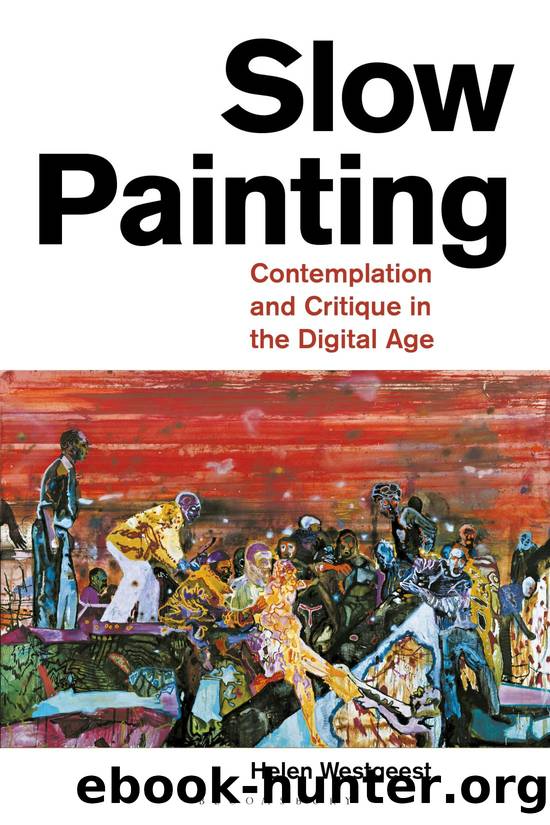Slow Painting by Helen Westgeest;

Author:Helen Westgeest;
Language: eng
Format: epub, pdf
ISBN: 9781501353079
Publisher: Bloomsbury USA
Figure 3.2 Jeff Wall, Dead Troops Talk (A Vision after an Ambush of a Red Army Patrol, near Moqor, Afghanistan, Winter 1986), 1992, transparency in light box, 229 Ã 417 cm. Courtesy of the artist.
According to Kozol, contemporary artists often remained involved in the dominant visual regimes that they criticized. The artworks she discussed in Distant Wars Visible deal with historical witnessing by means of imaginary processes of remembering, retelling, and reconstructing traces of conflicts from the past.45 Although she does not mention Wallâs picture, her observation is well applicable to his work. In reflections on his artworks, Wall showed his awareness of the ambiguities associated with his work. In his art he has pursued a contemporary relationship with reportage qualityâas assumed to be unique to photographyâin the sense that his photographs may strongly remind people of snapshots without his pretending them to be snapshots.46 This implies that spectators may initially look at his photographs on the basis of expectations related to photojournalism, while closer reading of the pictures will subsequently reveal that in fact they were meticulously composed. An unwanted consequence of this shift in perception, according to Wall, is that the viewer might get the feeling âthat the construction contains everything, that there is no âoutsideâ to it the way there is with photography in general.â47 In particular in photojournalism, the image is obviously a fragment of a greater whole which cannot be experienced directly, while awareness of an outer-frame presence may significantly contribute to the meaning of the image. Wall has expressed his worries that spectators who assume that his pictures lack such âoutsideâ will miss the importance of it for understanding his work.48 Building on this observation, it is interesting to apply Wallâs thoughts on the supposed lack in constructed images of a relationship with the outer world in the form of outer frame to paintings. For example, the outer-frame reality of a painting can be seen as that which was left out by the artist, so as to widen the common focus on what is present.
Wallâs reflection on the loss of framing as drawn boundaries may also be approached from other perspectives. Victor Burgin, in âThe Image in Pieces: Digital Photography and the Location of Cultural Experienceâ (1996), has argued that while photography in the nineteenth century emerged at a time when the West was drawing boundaries (e.g., the 1884 Berlin Conference, where Western nations divided Africa among themselves as their colonies), digital photography arose in a period of shifting or disappearing boundaries. In other words, not only geopolitical borders vanished but also borders within (and between) media.49 Most literally, this comment relates to Wallâs remark that computer technology mainly helped him to soften the boundaries between âthe probable and the improbable.â50 More in general, the boundaries between the inner- and outer-frame worlds in pictures such as Dead Troops Talk and Last Riot 2, Tondo #22 are not just a matter of transcending a photographic frame. The issue is more complicated, and such boundaries call
Download
This site does not store any files on its server. We only index and link to content provided by other sites. Please contact the content providers to delete copyright contents if any and email us, we'll remove relevant links or contents immediately.
The Art of Boudoir Photography: How to Create Stunning Photographs of Women by Christa Meola(18474)
Red Sparrow by Jason Matthews(5322)
Harry Potter 02 & The Chamber Of Secrets (Illustrated) by J.K. Rowling(3599)
In a Sunburned Country by Bill Bryson(3451)
Drawing Cutting Edge Anatomy by Christopher Hart(3422)
Figure Drawing for Artists by Steve Huston(3347)
Harry Potter and the Prisoner of Azkaban (Book 3) by J. K. Rowling(3250)
The Daily Stoic by Holiday Ryan & Hanselman Stephen(3195)
Japanese Design by Patricia J. Graham(3080)
The Roots of Romanticism (Second Edition) by Berlin Isaiah Hardy Henry Gray John(2853)
Make Comics Like the Pros by Greg Pak(2821)
Stacked Decks by The Rotenberg Collection(2774)
Draw-A-Saurus by James Silvani(2612)
Harry Potter and the Deathly Hallows (7) by J.K. Rowling(2609)
Tattoo Art by Doralba Picerno(2565)
On Photography by Susan Sontag(2542)
Churchill by Paul Johnson(2468)
The Daily Stoic by Ryan Holiday & Stephen Hanselman(2424)
Foreign Devils on the Silk Road: The Search for the Lost Treasures of Central Asia by Peter Hopkirk(2407)
